James McGirr – from Parkes to Premier
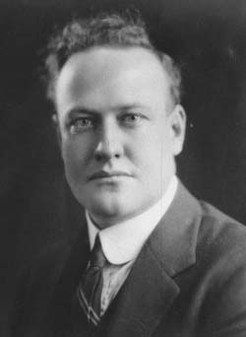
Photograph of James (Jim) McGirr, taken by an unknown photographer in 1932. Source: Australian Dictionary of Biography website
One of more famous surnames within the Parkes Shire is McGirr. The McGirrs were among the pioneers of Parkes and their influence was great not just in Parkes but also spread throughout New South Wales.
James McGirr was the Labor Premier of New South Wales from 6 February 1947 to 3 April 1952. Born in Parkes of pioneer stock, McGirr rose up to become the 28th Premier of the then colony of New South Wales. He was the tenth NSW premier to have been born in Australia – with overseas premiers having been born in England, Scotland, Ireland, India and New Zealand. Of the ten Australian-born premiers, he was the fifth one to be born in a country town – Sir Joseph Carruthers (Kiama); Charles Wade (Singleton); John Storey (Huskisson); and William McKell (Pambula) (Source: Wikipedia)
EARLY LIFE
James Theophalus McGirr was born in Parkes on 6 February 1890. He was the seventh child of Irish-born parents, John Patrick McGirr and Mary Teresa, née O’Sullivan. The order and details of the McGirr family, who were all born in Parkes, are as follows:
- Patrick Michael – Born 1875
- Margaret (Maggie) – Born 1876
- John Joseph Gregory – Born 1879
- Mary Amelia (Minnie) – Born 1881
- Anne Anastasia (Annie) – Born 1885
- Peter Aloysius – Born 1886
- James Theophalus (Jim) – Born February 6, 1890
Jim’s parents were both born in Ireland. Father John Patrick McGirr came to Australia from County Mayo. Jim’s mother, then Miss Mary Teresa O’Sullivan, came from County Clare when she was seventeen years old. For a few years she resided in Bathurst before moving to Parkes. A few years later she married John Patrick McGirr and the two resided in Parkes at “Tara Villa” in Gap Street. Jim’s father was described as industrious and influential in his obituary.
Like many of our grand old pioneers the late Mr McGirr was attracted to Australia by visions of rich goldfields and rapidly acquired affluence. He was well-connected in Ireland (his native land) being closely related to Archbishop McHale, of Tieam; a brother of the Rev. Peter McGirr, P.P. of Ballendine, and a nephew of the famous Australian Missioner of the mining days, the Rev. Father John McGirr, who was the first parish priest stationed at Parkes. It was 58 years ago when the subject of our sketch arrived in Australia and settled in Parkes. For many years he engaged in dairying, and also tried his luck at mining, but without much success. In the early days of Parkes he took contracts with the late Mr John Metcalfe and they were responsible for laying out many of the principal streets of the town.
Jim’s schooling and vocations were heavily influenced by his family.
Jim grew up on a small dairy farm. After early schooling locally, he attended St Stanislaus’ College, Bathurst. At the age of 16 he was apprenticed to his brother John Joseph McGirr, a pharmacist at Parkes. Jim was an accomplished horseman and soon abandoned pharmacy to work at the nearby stockyards. Thrown from his horse while mustering, he badly broke his leg and spent three months in bed. After this experience he resumed his apprenticeship. Having passed chemistry (1910), botany and materia medica (1911) at the University of Sydney, and the required examinations under the Pharmacy Act (1897), he was registered as a pharmacist on 12 August 1913. McGirr was employed in a large chemist shop in Sydney and joined the Shop Assistants’ Union of New South Wales before operating pharmacies in partnership with his brother Greg. He began his own pharmaceutical business at Parkes, specializing in veterinary products, and bought an 800-acre (325 ha) property in the district.
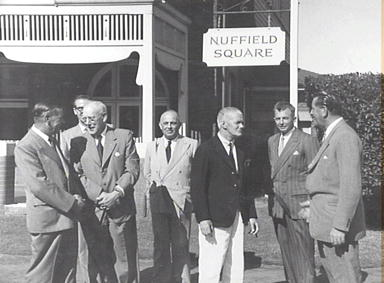
Group of men including Lord Nuffield and Premier James McGirr at Nuffield Square, Sydney factory of British Motor Corporation, Zetland. The address is between Joynton Avenue and South Dowling Street, Zetland. Nuffield Square was on the site of Old Victoria Park Racecourse and was purchased by Lord Nuffield for an assembly plant for Morris Minor and Oxford cars in 1950. Source: City of Sydney Archives
POLITICAL LIFE
The McGirr family were interested in politics and were to play integral parts in the development of the recently federated state of New South Wales.
Like his brothers Greg and Patrick Michael, Jim McGirr was active in Labor politics. He joined the Parkes branch in 1906 and held various offices. In 1922 Greg vacated his Legislative Assembly seat of Cootamundra for a Sydney electorate, simultaneously arranging through party intrigue for his place to be taken by Jim, who was elected that year. The other Labor member for Cootamundra, Peter Loughlin, was a strong opponent of Greg McGirr and successfully prevented Jim from being pre-selected for the 1925 election, despite appeals to the federal and State executives. In the face of some initial local resistance, Jim was selected and stood for Cumberland. A strong campaigner and a powerful orator, he was duly elected. With the return to single-member electorates in 1927, he won Bankstown, which he retained until 1950, then represented Liverpool.

Excerpt from a newspaper report detailing James McGirr’s troublesome start to his political career. Source: Daily Examiner Tuesday 21 April, 1925, p. 5
The Roaring Twenties led into the next decade – which would start with the Great Depression and end with a second world war still playing out! State politics was also a source of great commotion and turbulence. Jack Lang was premier for a second time in October 1930. Lang described McGirr as ‘the solid type, entirely different to his brother, the flamboyant Greg’. McGirr came equal first in the ballot for the ministry with 39 out of 55 votes. Lang demonstrated his belief in McGirr
[McGirr] served as minister for health (4 November 1930 to 17 June 1931) and held the local government portfolio (17 June 1931 to 13 May 1932). The government combined railways, tramways, main roads and motor transport under a single portfolio and, on 22 March 1932, McGirr also became the State’s first minister for transport.
With the Great Depression at its worst – more than one in five adult males in New South Wales were without a job – this was one of the highest rates of unemployment in the world (Schedvin (1970) cited in Dr David Gruen (2009) What Have We Learnt? The Great Depression in Australia from the perspective of today) . Lang devised a programme for economic recovery which became known as the “Lang Plan”. At an economic crisis conference in Canberra, the Lang plan was rejected by the Prime Minister and all other State Premiers. In contrast, the people of NSW seemed to flock to Lang’s lectures and speeches. His followers promoted slogans such as “Lang is Right” and “Lang is Greater than Lenin”. The irony of the time was that Lang loathed the Communist Party of Australia, who in turn denounced him as a social fascist. With the fervour of state politics at this time, and due to McGirr’s transport portfolio combining railways, tramways, main roads and motor transport, McGirr himself was dubbed “Commissar for Transport”. (Sources: Australian Dictionary of Biography website and Wikipedia) The end result of the “Lang plan” was a schism in the Labor party, both at state and federal levels. Division lines were drawn up, with McGirr such a staunch Langite that when Jack Lang temporarily left the Labor Party in 1940, McGirr was one of seven State parliamentarians who followed him. When William McKell became Premier in 1941, McGirr was the only ex-Langite to be included in the Premier’s cabinet. McKell made McGirr the Minister for Local Government and Housing. In 1942 McGirr established the Housing Commission of New South Wales. This became an integral state body dealing with the post-World War II and post-Depression housing shortage.
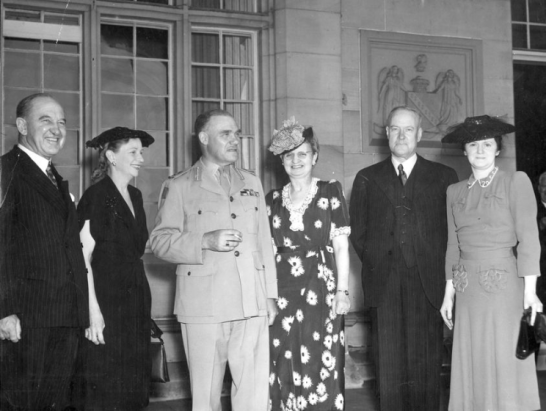
Photograph of Governor General of Australia, Mr W. J. McKell and Mrs McKell, Governor of N.S.W., Lt. General Northcott, Mrs Northcott, the Premier of N.S.W., Mr James McGirr, and Mrs McGirr at the state luncheon at Government House circa 1947. Source: State Library of Victoria Archives
In 1947, Prime Minister Ben Chifley named McKell as Governor-General of Australia. This created more ructions in the state Labor party:
In February 1947 McKell resigned to serve as governor-general. The struggle for the succession was bitter, the two main contenders being McGirr and the minister for education Robert Heffron who had the support of the party executive, the majority of cabinet and McKell himself. McGirr drew his strength from the anti-McKell forces in caucus. His chief organizers were Clive Evatt and a back-bencher C. H. Matthews. The Langite rump strongly backed him. As a practising Catholic with a rural background—in contrast to the former trade-union radical Heffron—McGirr also attracted support from his co-religionists and country members. On 6 February he finally triumphed (by two votes) on the fourth ballot, and was sworn in as premier and treasurer. A number of members were so infuriated by McKell’s decision to participate in the ballot that they voted against Heffron as a protest. McGirr was a leader commanding only the barest of majorities.

Photograph of James McGirr at a Housing Commission home in Kingsgrove. Source: Ancestry.com.au used with Parkes Library subscription to Ancestry Library edition
Political historians have described McGirr as “…straightforward, decent and humane, the new premier was personally well liked and noted for his loyalty.” Opponents and political foes found him to be “vigorous” and “a doughty fighter”. However David Clune records several deficiencies which effected McGirr’s political career:
…. he was also given to hesitation and procrastination, and was overly suspicious of those around him. He lacked McKell’s political astuteness, and his ability to master the complexities of the premiership. As McGirr’s term progressed, the backlog of files in his office accumulated and increasingly disappeared into his ‘refrigerator—a repository of many schemes which the Premier never bothers to defrost’.
While notable highs included his determination and establishing of the Housing Commission of New South Wales; and being the first Premier to legislate the 40-hour week; sadly he was unable to bring the many factions within the party together. While McGirr’s Labor were returned to power in 1950, he was to rely heavily on two independents, J.W. Seiffert and J.L. Geraghty. Clune states that the
… arduous demands of coping with a hung parliament, and presiding over a fractious cabinet and caucus, took an increasing toll on McGirr’s health. On 2 April 1952 he resigned as premier. He left parliament on the following day to become chairman of the Maritime Services Board, a position he held until 1955, despite a furore about his lack of technical qualifications.
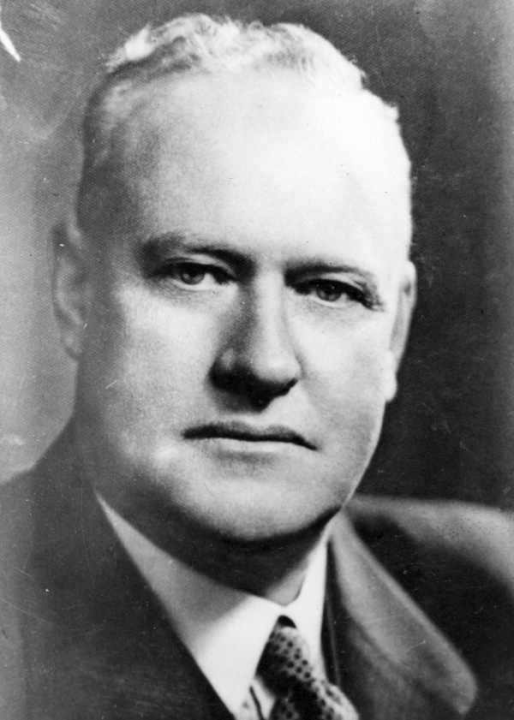
A 1947 black and white portrait of James McGirr, Premier of NSW. Source: National Library of Australia
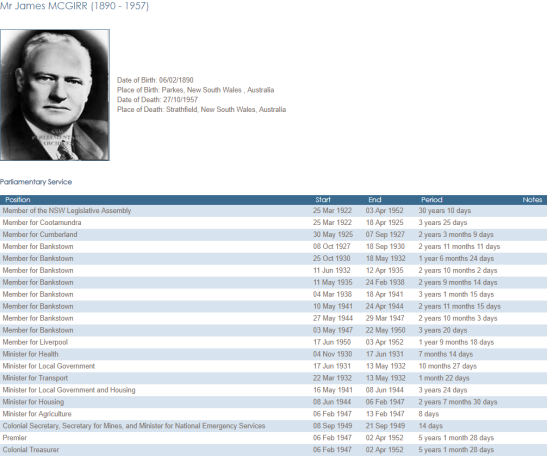
Listing of James McGirr’s parliamentary service. Source: Parliament NSW website
McGIRR’S LEGACY

Reproduction of the local newspaper report on the official ceremony of the McGirr – Renshaw Way (Note: This is known today as the Renshaw-McGirr Way or affectionately by locals as ‘the Wellington Road’) Source: Parkes Champion Post Monday August 1, 2005, p. 6
“Big Jim” (he was 183cm tall and weighed sixteen stone or 102kg) was a heavy smoker but never drank. He suffered chest pains while driving along the Hume Highway at North Bankstown one Sunday night. Fortunately one of his sons was accompanying him and he asked his son, James, to take him to a doctor’s surgery. Fifteen minutes later he was pronounced dead from a coronary occlusion. He was 66 years old.
The following tributes poured in from all sides of politics:
The whole of the McGirr family has served this State with singular distinction. None of them served with more devotion and distinction that Jim McGirr.
Premier Joseph Cahill
Mr McGirr was one of State Labour’s [sic] greatest stalwarts. He possessed qualities of mind and character that admitted of no compromise. He was a hard fighter in Parliament.
State Leader of the Opposition, Mr Morton
[I have] known Mr McGirr throughout his career in Parliament. His rising from a newcomer from the country to Premier in itself was a great achievement. I always look upon him as one of the great debaters we have had in this House. I do not know anyone who treated me with more courtesy.
Mr Bruxner, leader of the Country Party
I knew that his heart was ‘burnt out’ after 30 years of sterling public service, but I have lost a great friend. I was close to him and knew what a great person he was. His greatest attribute was his outstanding sense of loyalty – to his family and friends, and to the Australian Labor Party, which he served so well. His monument lives on in the thousands of hearts of people who benefited by his devotion to duty in so successfully launching the “Homes for the People” campaign which was his personal project. Australia has lost a noble son, one who sacrificed a professional career to service his people. Always a fighter for the rights and needs of his constituents, James McGirr made many friends who respected his honesty, frankness and his great devotion to his family.
Jack Mannix, McGirr’s successor as Member for Liverpool

A 1961 photograph of the older section of Liverpool District Hospital’s maternity wing named after James McGirr. Source: National Archives of Australia
James McGirr’s niece – Rachel Trixie Anne Gardner, Baroness Gardner of Parkes, AM FRSA, JP – became a Conservative politician in the United Kingdom and is the only Australian woman made a life peeress of the UK parliament.
Renshaw-McGirr Way – the road connecting Parkes to Wellington – is named after two premiers, Jim McGirr and Wellington-born Premier John Brophy “Jack” Renshaw (Labor Premier from 30 April 1964 to 13 May 1965 and also the first NSW Premier born in the 20th Century)
McGirr Street, located on the southern side of Parkes, was named after the McGirr family in 1929 and was a part of James McGirr’s Subdivision (Western Champion Thursday 31 January 1929 page 11)
The maternity wing of Liverpool District Hospital, was named after James McGirr.
During his time as Premier, McGirr attempted to upgrade Dubbo Hospital. The State Government Architect who drew up the designs for McGirr’s improvements was Cobden Parkes.
To read more about Cobden Place click here
Parkes Shire Library would like to thank the following people and organisations for their assistance with this blog post:
- Australian Dictionary of Biography website;
- Deanna Kearney;
- Eileen Newport;
- Trove;
- Parkes Champion Post;
- David Nash;
- Parkes Shire Council; and
- staff of Parkes Shire Libraries.
If you have stories of Jim McGirr that you are willing to share please contact Parkes Shire Library via library@parkes.nsw.gov.au so that they can be shared and kept for posterity on this blog. Alternatively, you may leave comments on this page.
REFERENCE LIST
- Unknown. (2000). James McGirr [Digital image]. Retrieved May 2, 2019, from http://adb.anu.edu.au/biography/mcgirr-james-jim-10957
- Premier of New South Wales. (April 8, 2019). Retrieved May 8, 2019, from https://en.wikipedia.org/wiki/Premier_of_New_South_Wales
- OBITUARY. (November 26, 1925). Western Champion (Parkes, NSW : 1898 – 1934), p. 13. Retrieved May 31, 2019, from http://nla.gov.au/nla.news-article113545930
- Clune, David (2000). Australian Dictionary of Biography. Retrieved April 16, 2019, from http://adb.anu.edu.au/biography/mcgirr-james-jim-10957
- Baglin, Douglass (n.d.). [Group of men including Lord Nuffield and Premier James McGirr at Nuffield Square, Sydney factory of British Motor Corporation, Zetland.]. Retrieved May 31, 2019, from http://www.photosau.com.au/cos/scripts/ExtSearch.asp?SearchTerm=033277
- JAMES McGIRR’S NOMINATION. (April 21, 1925). Daily Examiner (Grafton, NSW : 1915 – 1954), p. 5. Retrieved May 30, 2019, from http://nla.gov.au/nla.news-article195367525
- Gruen, Dr David (November 11, 2009). What Have We Learnt? The Great Depression in Australia from the perspective of today. Speech presented at 19th Annual Colin Clark Memorial Lecture, Brisbane. Retrieved May 31, 2019, from http://archive.treasury.gov.au/documents/1689/PDF/03_Colin_Clark_speech.pdf
- State Library of Victoria. (n.d.). [Governor General of Australia, Mr W. J. McKell and Mrs McKell, Governor of N.S.W., Lt. General Northcott, Mrs Northcott, the Premier of N.S.W., Mr James McGirr, and Mrs McGirr at the state luncheon at Government House]. Retrieved May 30, 2019, from https://viewer.slv.vic.gov.au/?entity=IE221896&mode=browse
- cathymac09. (August 1, 2011). [Photograph of Premier James McGirr at a NSW Housing Commission home in Kingsgrove]. Retrieved May 31, 2019, from https://www.ancestrylibrary.com.au/mediaui-viewer/collection/1030/tree/114391103/person/170151923790/media/9f1971c1-84f6-4d58-8e03-7796a67a288e?_phsrc=bDB285&usePUBJs=true
- Herald and Weekly Times kept by National Library of Australia. (n.d.). A 1947 black and white portrait of James McGirr, Premier of NSW [Digital image]. Retrieved May 8, 2019, from https://commons.wikimedia.org/wiki/File:JamesMcGirr1947.jpg
- Parliament of New South Wales. (n.d.). Parliamentary Service of Mr James McGirr [Digital image]. Retrieved May 8, 2019, from https://www.parliament.nsw.gov.au/members/Pages/member-details.aspx?pk=1497
- Mr. J. McGirr Dies At 66 (October 28, 1957). The Canberra Times (ACT : 1926 – 1995), p. 2. Retrieved May 31, 2019, from http://nla.gov.au/nla.news-article91241062
- Tributes To Mr. J, McGirr (October 30, 1957). The Canberra Times (ACT : 1926 – 1995), p. 6. Retrieved May 31, 2019, from http://nla.gov.au/nla.news-article91241278
- DEATH OF EX-PREMIER (October 30, 1957). The Biz (Fairfield, NSW : 1928 – 1972), p. 15. Retrieved May 31, 2019, from http://nla.gov.au/nla.news-article189941570
- Official ceremony to mark sealing of McGirr-Renshaw Way (August 1, 2005) Parkes Champion Post, p. 6.
- NEW STREETS. (January 31, 1929). Western Champion (Parkes, NSW : 1898 – 1934), p. 11. Retrieved May 31, 2019, from http://nla.gov.au/nla.news-article113459466
- MUNICIPALITY OF PARKES.—NAMING OF ROADS.—Notice (November 9, 1973). Government Gazette of the State of New South Wales (Sydney, NSW : 1901 – 2001), p. 4917. Retrieved May 31, 2019, from http://nla.gov.au/nla.news-article220152085
- Adaptive Architects. (December, 2016). Heritage Impact Statement – Dubbo Health Service Redevelopment Stages 3 & 4 State Significant Development(Australia, NSW Health Infrastructure, NSW Health). Retrieved May 31, 2019, from file:///C:/Users/Dan.fredericks/Downloads/Appendix R_Heritage Impact Statement_Part1.pdf
- Official Ceremony to mark sealing of McGirr – Renshaw Way. (August 1, 2005). Parkes Champion Post, p. 6.
- [Health – Hospitals – The older section of the Liverpool District Hospital, 20 miles from Sydney, is the maternity wing, named after a former Premier of New South Wales, James McGirr [photographic image]. 1 photographic negative: b&w, acetate Date 1961]. (n.d.). Retrieved May 30, 2019, from https://recordsearch.naa.gov.au/SearchNRetrieve/Interface/DetailsReports/PhotoDetail.aspx?Barcode=9759312
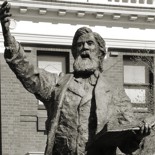
This is a great piece of research…well done. McGirr was a great contributo to NSW and to Parkes. I would be interested in additional details on his life in Parkes. I believe there are a number of local houses associated with the McGirr family and it would be valuable to celebrate these as landmarks of his contribution. Could you locate further details and advise please.
LikeLike
Thank you for your feedback, David. One of the beauties of this blog is that we can add to each post when we uncover or come across additional information. One of my reflections before publishing was that there was not a great detail of McGirr’s life in Parkes – so it is definitely an area I would like more information on. While the call is thrown out to members of the public and our many readers, I will also look into it too. Thanks again, David
LikeLike